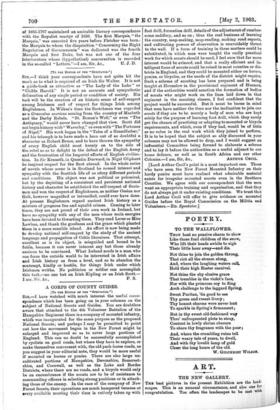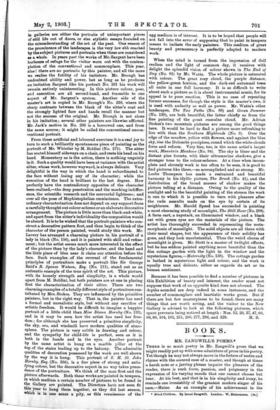ART.
THE NEW GALLERY.
THE best pictures in the present Exhibition are the land- scapes. This is an unusual circumstance, and also one for congratulation. Too often the landscapes to be met with in galleries are either the portraits of unimportant pieces of still life out of doors, or else stylistic essays founded on the misunderstanding of the art of the past. One reason of the prominence of the landscapes is the very low ebb reached by the subject pictures and portraits when these are considered as a whole. In years past the works of Mr. Sargent have been harbours of refuge for the visitor worn out with the contem- plation of the conventional and commonplace. This year, alas ! there are no portraits by this painter, and all the more we realise the futility of his imitators. Mr. Brough has undoubted ability and power, but as long as he produces an imitation Sargent like his portrait No. 261 his work will remain entirely uninteresting. In this picture colour, pose, and execution are all second-hand, and traceable to one aspect of Mr. Sargent's system. Another side of the master's art is copied in Mr. Brough's No. 238, where the sharp contrasts between the black of the sitter's coat and the strongly lighted face and hands recall the manner but not the success of the original. Mr. Brough is not alone in his imitation ; several other painters are likewise afflicted. Mr. Jack's motive in No. 286 is a borrowed one, and from the same source ; it might be called the conventional uncon- ventional portrait.
From these artificial and laboured exercises it is a real joy to turn to such a brilliantly spontaneous piece of painting as the portrait of Mr. Whistler by M. Boldini (No. 271). The sitter has seated himself sideways on a chair, and rests his head on his hand. Momentary as is the action, there is nothing ungainly in it. Such a quality would have been at variance with the artist sitter, whose work, however wayward, is always delicate. Very delightful is the way in which the hand is subordinated to the face without losing any of its character; while the execution of the head is brilliant to the last degree. How perfectly have the contradictory opposites of the character been realised,—the deep penetration and the mocking indiffer- ence, the scientific research and the mercurial lightness ; and over all the pose of Mepbistophelian omniscience. The extra- ordinary characterisation does not depend on any support from a carefully thought out colour-scheme or an elaborate decorative arrangement. The picture is little more than black-and-white, and apart from the sitter's individuality the composition would be absurd. It is to be wished that the portrait-painters who con- struct a decorative pattern first, and then begin to think of the character of the person painted, would study this work. Mr. Lavery has arranged a charming picture in his portrait of a lady in black (No. 156), and it is painted with skill and refine- ment; but the artist seems much more interested in the effect of the picture than by the lady's character, and the hand and the little piece of blue near it claim our attention before the face. Such examples of the reversal of the fundamental principles of portraiture make a portrait like Sir George Reid's R. Spence Watson, Esq. (No. 111), stand out as an authentic example of the true spirit of the art. This picture, with its homely strength and simplicity, is a whole world apart from M. Boldini, but both painters are at one in placing first the characterisation of their sitter. There are two
charming examples of a totally different style of portraiture con- tributed by Mrs. Stokes. They are influenced by the primitive painters, but in the right way. That is, the painter has used
a formal and unrealistic style, but without any sacrifice of artistic freedom. It would be difficult to imagine a happier portrait of a little child than Miss Diana Hornby (No. 133),
and in it may be seen how the artist has used her free- dom ; for although she has preserved a primitive simplicity, the sky, sea, and windmill have modern qualities of atmo- sphere. The picture is very subtle in drawing and colour, and the sympathy for child-life is perfect, seen as it is both in the hands and in the eyes. Another portrait by the same artist is hung on a marble pillar at the top of the stairs leading up to the balcony. The admirable
qualities of decoration possessed by the work are well shown by the way it is hung. This portrait of S. H. St. John Hornby, Esq. (No. 356), is a fine piece of strong and satis-
fying colour, but the decorative aspect in no way takes prece-
dence of the portraiture. We think of the man first and the picture afterwards. Both these works are painted in tempera,
in which medium a certain number of pictures to be found in the Gallery are painted. The Directors have not seen fit this year to hang them together, as they did last season, which is in one sense a pity, as this renaissance of the
egg medium is of interest. It is to be hoped that people will not fall into the error of supposing that to paint in tempera means to imitate the early painters. This medium of great beauty and permanency is perfectly adapted to modern work.
When the mind is turned from the impression of dull realism and the light of common day, it receives with delight the splendid vision of colour shown in The End of Day (No. 92) by Mr. Watts. The whole picture is saturated with colour. The great rosy cloud, the purple distance, the yellow-green horizon, and the dark-red autumnal trees all unite in one full harmony. It is as difficult to write about such a picture as it is about instrumental music, for its appeal is to pure emotion. This is no case of repeating former successes, for though the style is the master's own, it is used with audacity as well as power. Mr. Watts's other landscapes, The Two Paths (No. 88) and Green Summer (No. 139), are both beautiful, the latter chiefly so from the fine painting of the great cumulus cloud. Mr. Adrian Stokes's two mountain pictures are among the good things here. It would be hard to find a picture more refreshing to live with than the Southern Highlands (No. 9). Over the edge of the meadow, yellow with flowers, and against the blue sky, rise the Dolomite precipices, round which the white clouds form and reform. Very fine, too, is the same artist's larger work, Mountain Meadows (No. 94). The sky is bluer and the distant pine forests, with their ultramarine shadows, give a stronger tone to the colour-scheme. At a time when incom- plete and slovenly work is too often to be seen, it is good to find pictures like these,—so accomplished and so strong. Mr. Leslie Thompson has made a restrained and beautiful harmony in his idyllic picture, The Brook (No. 41), and the distribution of the broad masses of shadow makes the picture telling at a distance. Owing to the quality of the sunlight and to the beautiful painting of the stream the work is one to which it is possible to turn with pleasure after the rude assaults made on the eye by certain of its neighbours. Mr. Harold Speed has succeeded in painting a moat charming study of moonlight, The Still Hour (No. 208). A farm cart, a haystack, an illuminated window, and a black cat with green eyes are the materials of the picture. The artist has thoroughly succeeded in representing the meta- morphosis of moonlight. The solid objects are all there with their usual shapes, but the appearance of their solidity has gone, and they look unsubstantial. Thus the weird charm of moonlight is given. Mr. Stott is a master of twilight effects, but he has seldom painted anything more beautiful than the dim cottage garden with the light in the window and the mysterious figures,—Maternity (No. 138). The cottage garden is bathed in mysterious light and colour, and the work is equally true and delicate, either as regards its art or its human sentiment.
Because it has been possible to find a number of pictures in this Exhibition of beauty and interest, the reader must not suppose that work of an opposite kind does not abound. The depths sounded are deep indeed in some instances, and the number of commonplace and inartistic works great. But if there are but few masterpieces to be found, there are many things that are worth seeing, and the visitor to the New Gallery is advised to look at the following pictures, which space prevents being noticed at length : Nos. 13, 20, 37, 47, 60,
68, 80, 104, 105, 251, 260, 277, 286, and 328. H. S.











































 Previous page
Previous page